A Quadruple Notch UWB Antenna with Decagonal Radiator and Sierpinski Square Fractal Slots
Abstract
:1. Introduction
2. UWB Antenna Design Approach
2.1. Progression of UWB Antenna
2.2. Ground Plane Truncation Effect
2.3. Parametric Analysis
2.3.1. Effect of Truncation Length T
2.3.2. Effect of Length T1
2.3.3. Effect of Feed Width Wf
2.4. Current Distribution
3. UWB Notch Antenna Design
3.1. Calculation of the Length of the Individual Stubs and Corresponding Notch Frequency
3.2. The Development of the UWB Notch Antenna
3.3. Parametric Analysis
3.3.1. Effect of Stub D Width N2
3.3.2. Effect of Stub C Width N3
3.3.3. Effect of Stub C Length N8
3.3.4. Effect of Stub B Length N10
3.3.5. Effect of Stub A Length N13
3.3.6. Effect of Stub A Length N15
3.4. Current Distribution at the Operating Frequency of UWB Notch Antenna
3.5. Current Distribution at Notch Frequency of UWB Notch Antenna
4. Analysis and Interpretation of Results
4.1. UWB Antenna Results
4.1.1. Measured and Simulated S11
4.1.2. Radiation Pattern
4.1.3. Time-Domain Analysis
4.1.4. The UWB Antenna’s Gain
4.2. UWB Notch Antenna Results
4.2.1. Measured and Simulated S11
4.2.2. The Radiation Pattern of Notch Antenna at Operating Band
4.2.3. Time-Domain Analysis
4.2.4. Comparison Table
5. Conclusions
Author Contributions
Funding
Institutional Review Board Statement
Informed Consent Statement
Data Availability Statement
Conflicts of Interest
References
- Federal Communications Commission (FCC). Revision of Part 15 of The Commission’s Rules Regarding Ultra-Wideband Transmission Systems. In First Report and Order; ET Docket: Washington, DC, USA, 2002; pp. 98–153. [Google Scholar]
- Kumar, O.P.; Kumar, P.; Ali, T.; Kumar, P.; Vincent, S. Ultrawideband Antennas: Growth and Evolution. Micromachines 2021, 13, 60. [Google Scholar] [CrossRef] [PubMed]
- Kumar, O.P.; Kumar, P.; Ali, T. A Compact Dual-Band Notched UWB Antenna for Wireless Applications. Micromachines 2021, 13, 12. [Google Scholar] [CrossRef]
- Kumar, P.; Pai, M.M.; Ali, T. Ultrawideband antenna in wireless communication: A review and current state of the art. Telecommun. Radio Eng. 2020, 79, 929–942. [Google Scholar] [CrossRef]
- Intrieri, E.; Gigli, G.; Gracchi, T.; Nocentini, M.; Lombardi, L.; Mugnai, F.; Casagli, N. Application of an ultra-wide band sensor-free wireless network for ground monitoring. Eng. Geol. 2018, 238, 1–14. [Google Scholar] [CrossRef]
- Srikanth, B.S.; Gurung, S.B.; Manu, S.; Gowthami GN, S.; Ali, T.; Pathan, S. A slotted UWB monopole antenna with truncated ground plane for breast cancer detection. Alex. Eng. J. 2020, 59, 3767–3780. [Google Scholar]
- Anguera, J.; Andújar, A.; Jayasinghe, J.; Chakravarthy, V.S.; Chowdary PS, R.; Pijoan, J.L.; Cattani, C. Fractal antennas: An historical perspective. Fractal Fract. 2020, 4, 3. [Google Scholar] [CrossRef] [Green Version]
- Benavides, J.B.; Lituma, R.A.; Chasi, P.A.; Guerrero, L.F. A novel modified hexagonal shaped fractal antenna with multi band notch characteristics for UWB applications. In Proceedings of the 2018 IEEE-Aps Topical Conference on Antennas and Propagation in Wireless Communications (AWPC), Colombia, CA, USA, 10–14 September 2018; IEEE: Piscataway, NJ, USA; pp. 830–833. [Google Scholar]
- Devana VK, R.; Satyanarayana, V.; Lakshmi, A.V.; Sukanya, Y.; Kumar, C.M.; Ponnapalli, V.P.; Jagadeesh Babu, K. A novel compact fractal UWB antenna with dual band notched characteristics. Analog. Integr. Circuits Signal Process. 2022, 110, 349–360. [Google Scholar] [CrossRef]
- Garg, R.K.; Nair MV, D.; Singhal, S.; Tomar, R. A new type of compact ultra-wideband planar fractal antenna with WLAN band rejection. Microw. Opt. Technol. Lett. 2020, 62, 2537–2545. [Google Scholar] [CrossRef]
- Hu, Z.; Hu, Y.; Luo, Y.; Xin, W. A novel rectangle tree fractal UWB antenna with dual band notch characteristics. Prog. Electromagn. Res. C 2016, 68, 21–30. [Google Scholar] [CrossRef] [Green Version]
- Bhattacharjee, A.; Karmakar, A.; Saha, A.; Bhattacharya, D. Design of a compact UWB MIMO-diversity antenna incorporating fractal inspired isolation structure with band notch characteristics. Microw. Opt. Technol. Lett. 2021, 63, 2597–2605. [Google Scholar] [CrossRef]
- Kodali, R.R.; Siddaiah, P.; Giriprasad, M.N. Design of Quad Band Operational UWB Antenna with Triple Notch Bands Using Meander Line Slot. Prog. Electromagn. Res. M 2021, 109, 63–73. [Google Scholar]
- Nan, J.; Zhao, J.Y.; Wang, Y. A Compact Dual Notch-Band Frequency Reconfigurable UWB Monopole Antenna. Prog. Electromagn. Res. M 2021, 106, 215–226. [Google Scholar] [CrossRef]
- Bharti, B.K.; Singh, A.K.; Gangwar, R.P.; Verma, R. Frequency and Time Domain Analysis of Triple Band Notched UWB Antenna with Integrated Bluetooth Band. Prog. Electromagn. Res. M 2021, 105, 109–118. [Google Scholar] [CrossRef]
- Kaur, K.; Kumar, A.; Sharma, N. Split Ring Slot Loaded Compact CPW-Fed Printed Monopole Antennas for Ultra-Wideband Applications with Band Notch Characteristics. Prog. Electromagn. Res. C 2021, 110, 39–54. [Google Scholar] [CrossRef]
- Lakrit, S.; Das, S.; Ghosh, S.; Madhav, B.T.P. Compact UWB flexible elliptical CPW-fed antenna with triple notch bands for wireless communications. Int. J. RF Microw. Comput.-Aided Eng. 2020, 30, e22201. [Google Scholar] [CrossRef]
- Chakraborty, M.; Pal, S.; Chattoraj, N. Quad notch UWB antenna using combination of slots and split-ring resonator. Int. J. RF Microw. Comput.-Aided Eng. 2020, 30, e22086. [Google Scholar] [CrossRef]
- Zou, Q.; Jiang, S. A compact flexible fractal ultra-wideband antenna with band notch characteristic. Microw. Opt. Technol. Lett. 2021, 63, 895–901. [Google Scholar] [CrossRef]
- Chen, L.; Ma, Q.; Luo, S.S.; Ye, F.J.; Cui, H.Y.; Cui, T.J. Touch-Programmable Metasurface for Various Electromagnetic Manipulations and Encryptions. Small 2022, 18, 2203871. [Google Scholar] [CrossRef] [PubMed]
- Ma, Q.; Bai, G.D.; Jing, H.B.; Yang, C.; Li, L.; Cui, T.J. Smart metasurface with self-adaptively reprogrammable functions. Light Sci. Appl. 2019, 8, 98. [Google Scholar] [CrossRef] [Green Version]
- Ma, Q.; Gao, W.; Xiao, Q.; Ding, L.; Gao, T.; Zhou, Y.; Cui, T.J. Directly wireless communication of human minds via non-invasive brain-computer-metasurface platform. Elight 2022, 2, 11. [Google Scholar] [CrossRef]
- Ali, T.; Subhash, B.K.; Biradar, R.C. A miniaturized decagonal Sierpinski UWB fractal antenna. Prog. Electromagn. Res. C 2018, 84, 161–174. [Google Scholar]
- Puri, S.C.; Das, S.; Tiary, M.G. UWB monopole antenna with dual-band-notched characteristics. Microw. Opt. Technol. Lett. 2020, 62, 1222–1229. [Google Scholar] [CrossRef]
- Choukiker, Y.K.; Behera, S.K. Modified Sierpinski square fractal antenna covering ultra-wide band application with band notch characteristics. IET Microw. Antennas Propag. 2014, 8, 506–512. [Google Scholar] [CrossRef]
- Gorai, A.; Pal, M.; Ghatak, R. A Compact fractal-shaped antenna for ultrawideband and bluetooth wireless systems with WLAN rejection functionality. IEEE Antennas Wirel. Propag. Lett. 2017, 16, 2163–2166. [Google Scholar] [CrossRef]
- Rahimi, M.; Heydari, S.; Mansouri, Z.; Gandji, N.P.; Zarrabi, F.B. Investigation and design of an ultra-wideband fractal ring antenna for notch applications. Microw. Opt. Technol. Lett. 2016, 58, 1629–1634. [Google Scholar] [CrossRef]
- Lakrit, S.; Das, S.; El Alami, A.; Barad, D.; Mohapatra, S. A compact UWB monopole patch antenna with reconfigurable Band-notched characteristics for Wi-MAX and WLAN applications. AEU-Int. J. Electron. Commun. 2019, 105, 106–115. [Google Scholar] [CrossRef]
- Lin, Y.; Liang, J.; Wu, G.; Xu, Z.; Niu, X. A novel UWB antenna with dual band-notched characteristics. Frequenz 2015, 69, 479–483. [Google Scholar] [CrossRef]
- Yang, B.; Qu, S. A compact integrated Bluetooth UWB dual-band notch antenna for automotive communications. AEU-Int. J. Electron. Commun. 2017, 80, 104–113. [Google Scholar] [CrossRef]
- Mishra, G.; Sahu, S. Compact circular patch UWB antenna with WLAN band notch characteristics. Microw. Opt. Technol. Lett. 2016, 58, 1068–1073. [Google Scholar] [CrossRef]
- Zarrabi, F.B.; Mansouri, Z.; Gandji, N.P.; Kuhestani, H. Triple-notch UWB monopole antenna with fractal Koch and T-shaped stub. AEU-Int. J. Electron. Commun. 2016, 70, 64–69. [Google Scholar] [CrossRef]
- Gao, G.; He, L.; Hu, B.; Cong, X. Novel dual band-notched UWB antenna with T-shaped slot and CSRR structure. Microw. Opt. Technol. Lett. 2015, 57, 1584–1590. [Google Scholar] [CrossRef]
- Kumar, A.L.; Ranjan, A.; Chauhan, M.; Killamsetty, V.K.; Mukherjee, B. Circular SRR shaped UWB antenna with WiMAX band notch characteristics. In Proceedings of the 2018 IEEE Radio and Antenna Days of the Indian Ocean (RADIO), Wolmar, Mauritius, 15–18 October 2018; IEEE: Piscataway, NJ, USA; pp. 1–2. [Google Scholar]
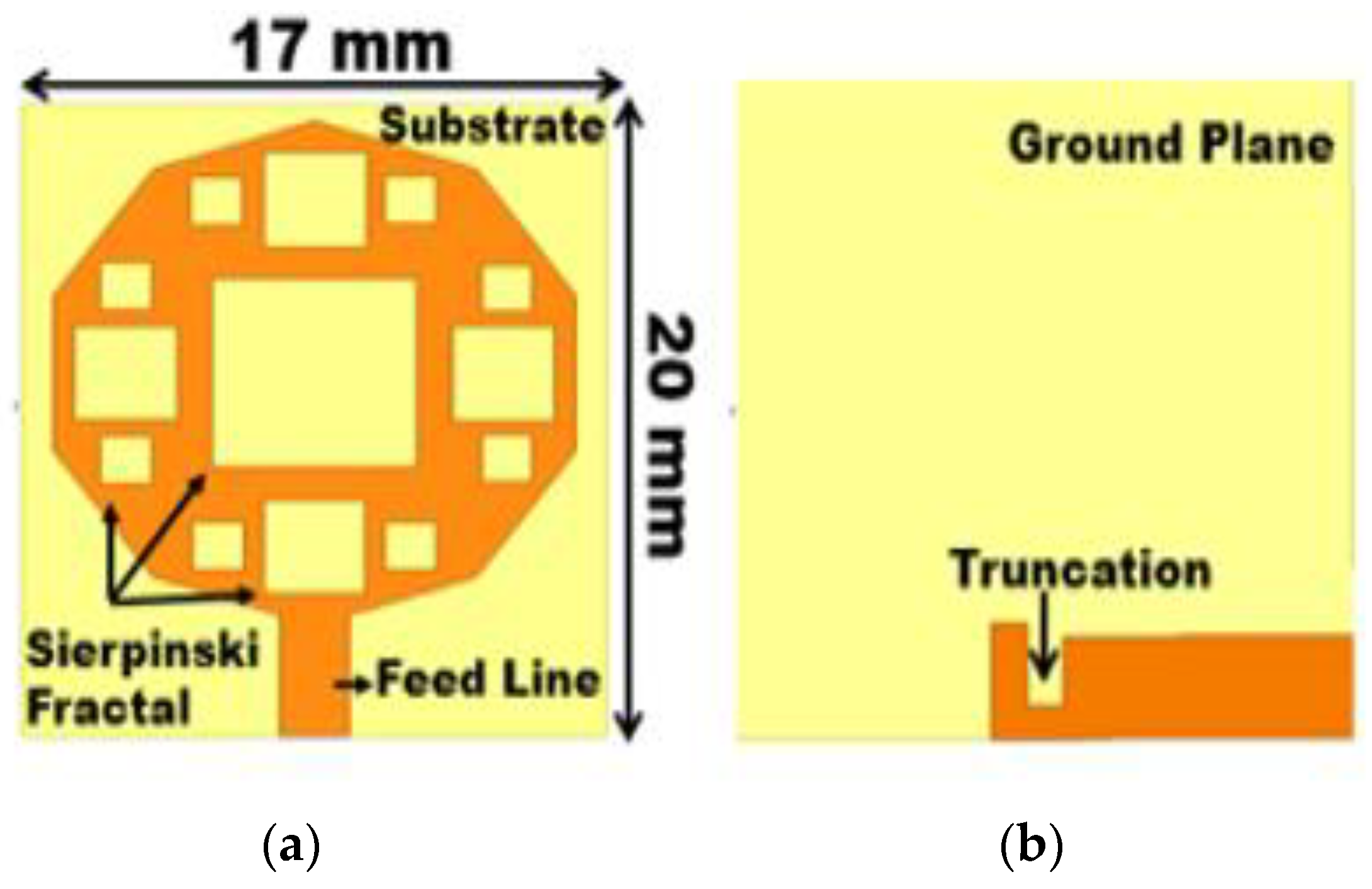
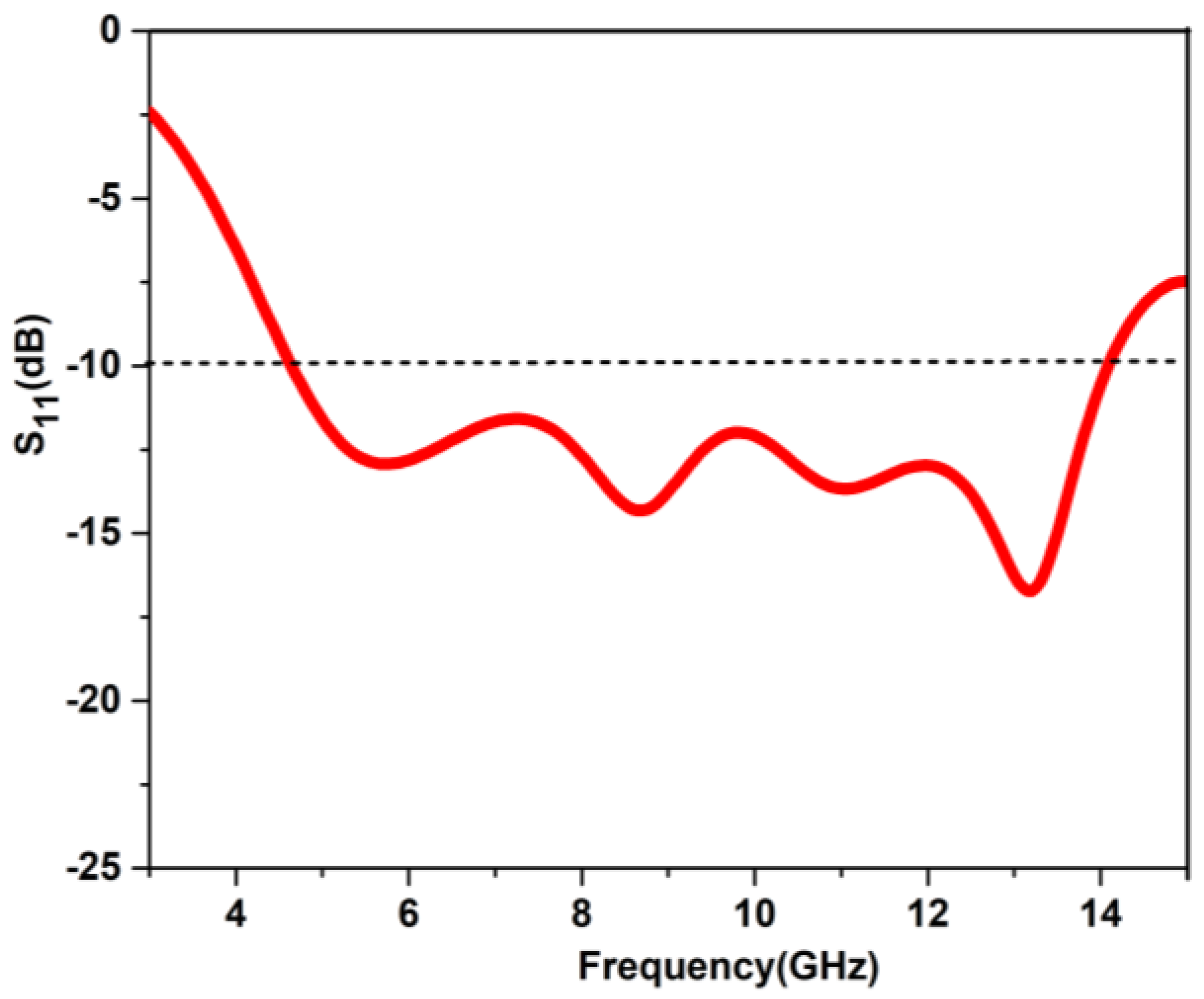
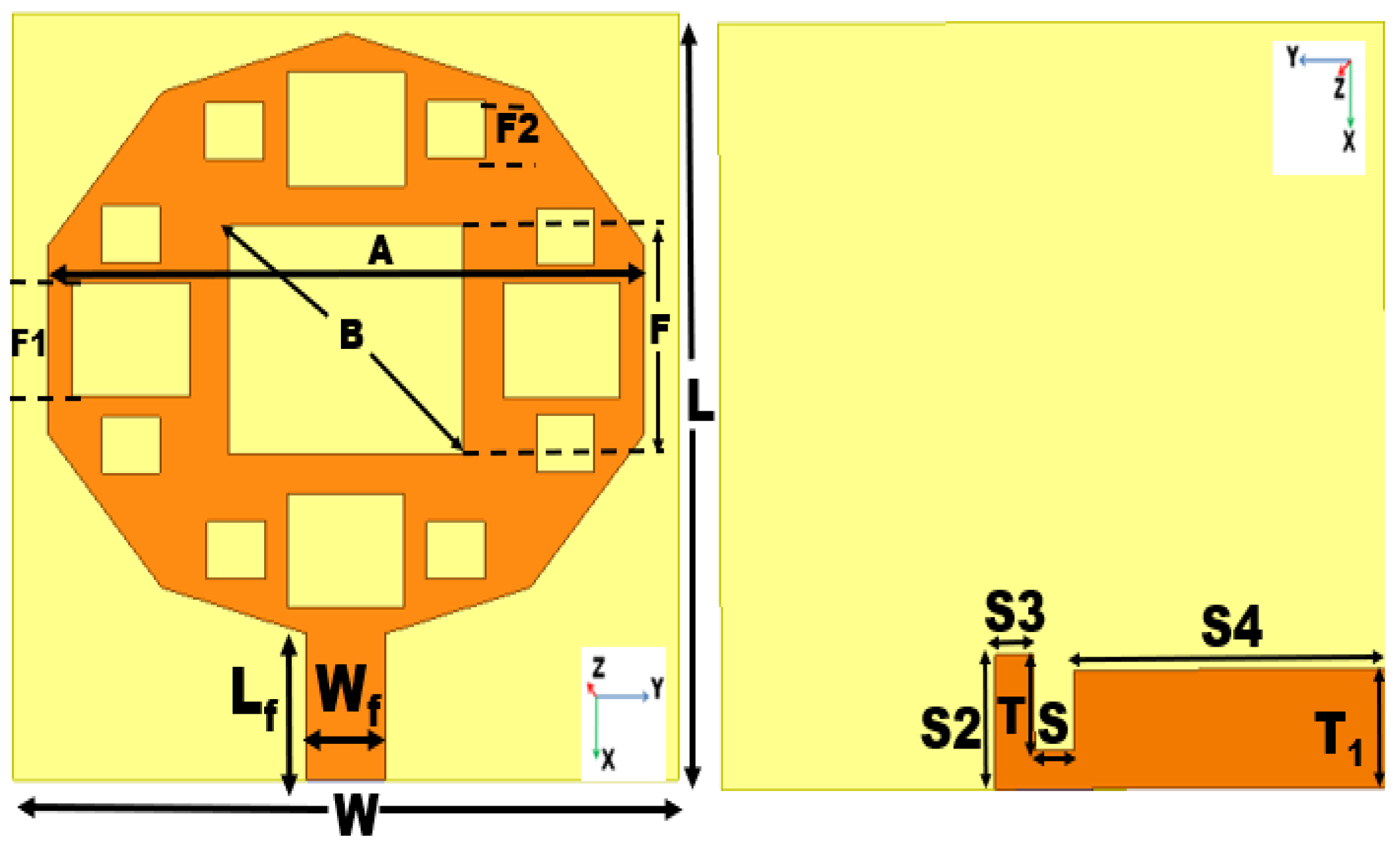
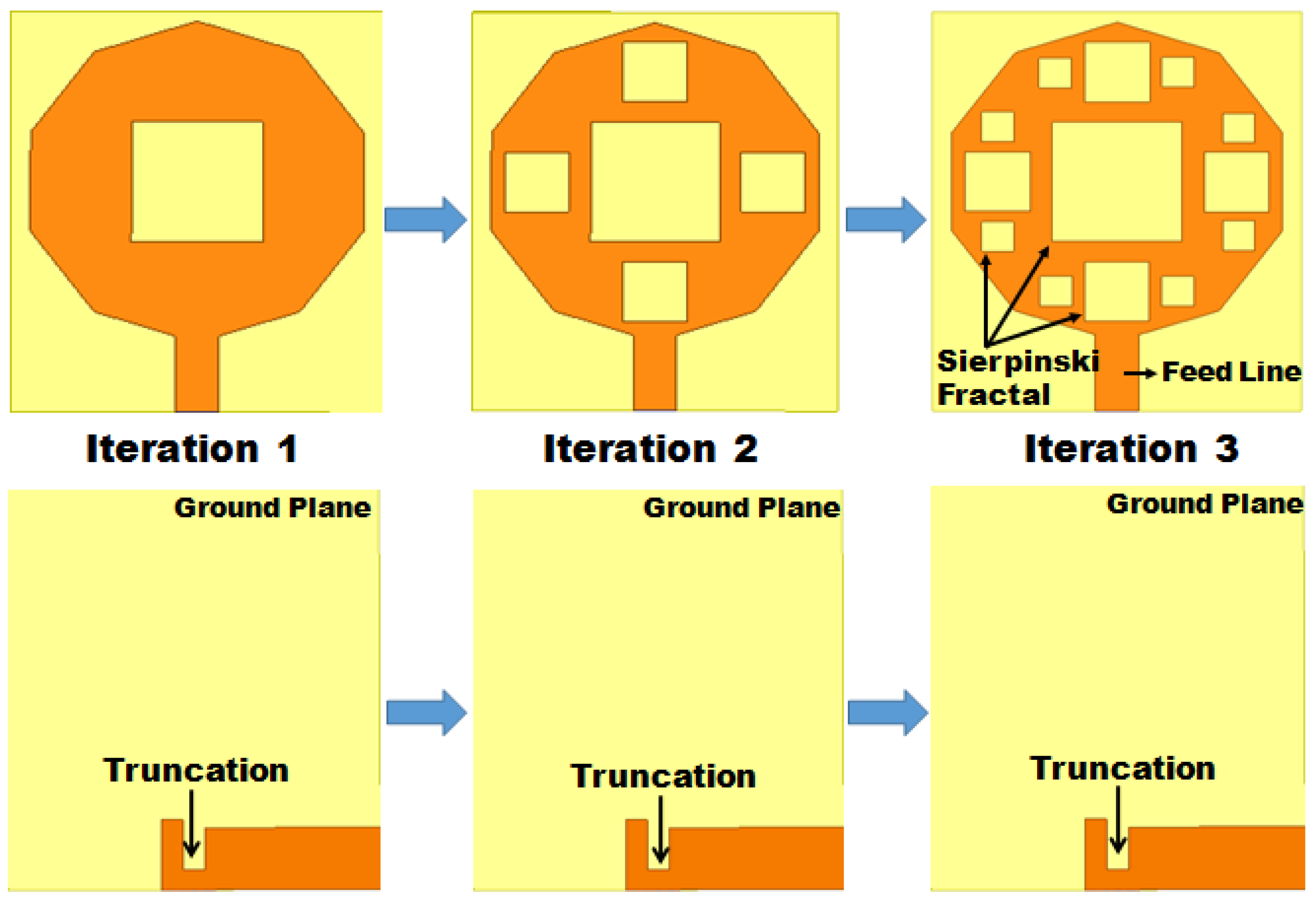



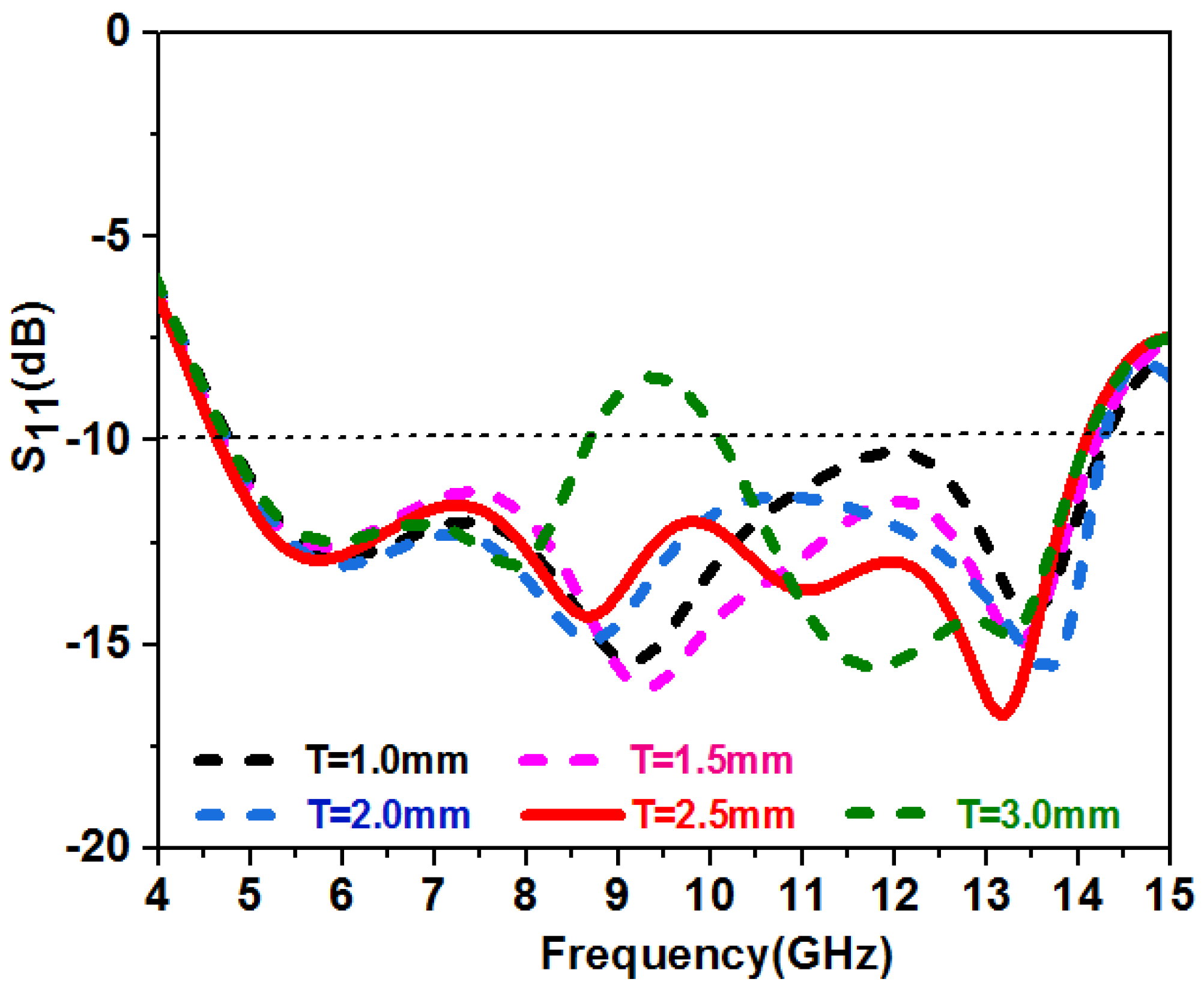

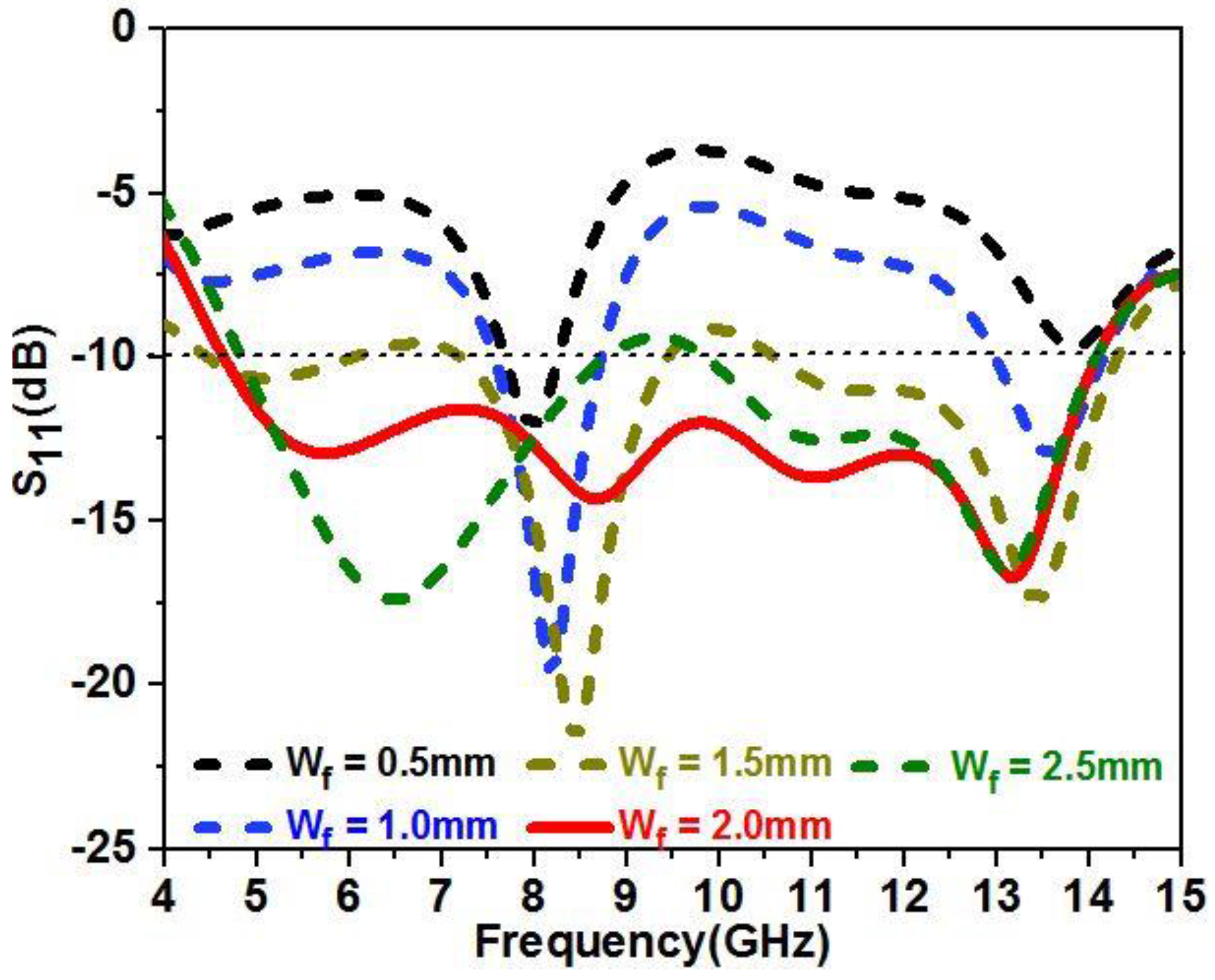
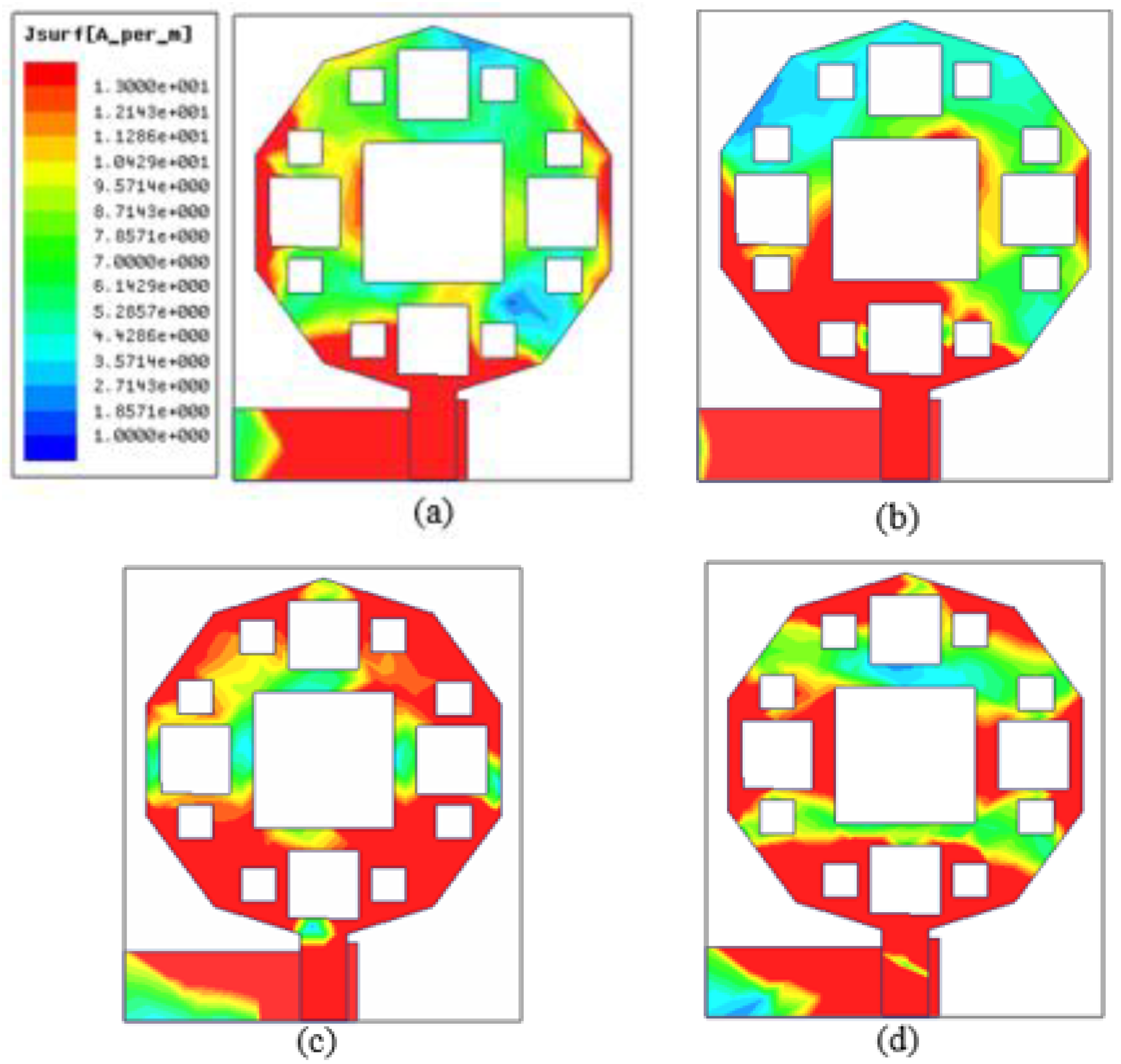
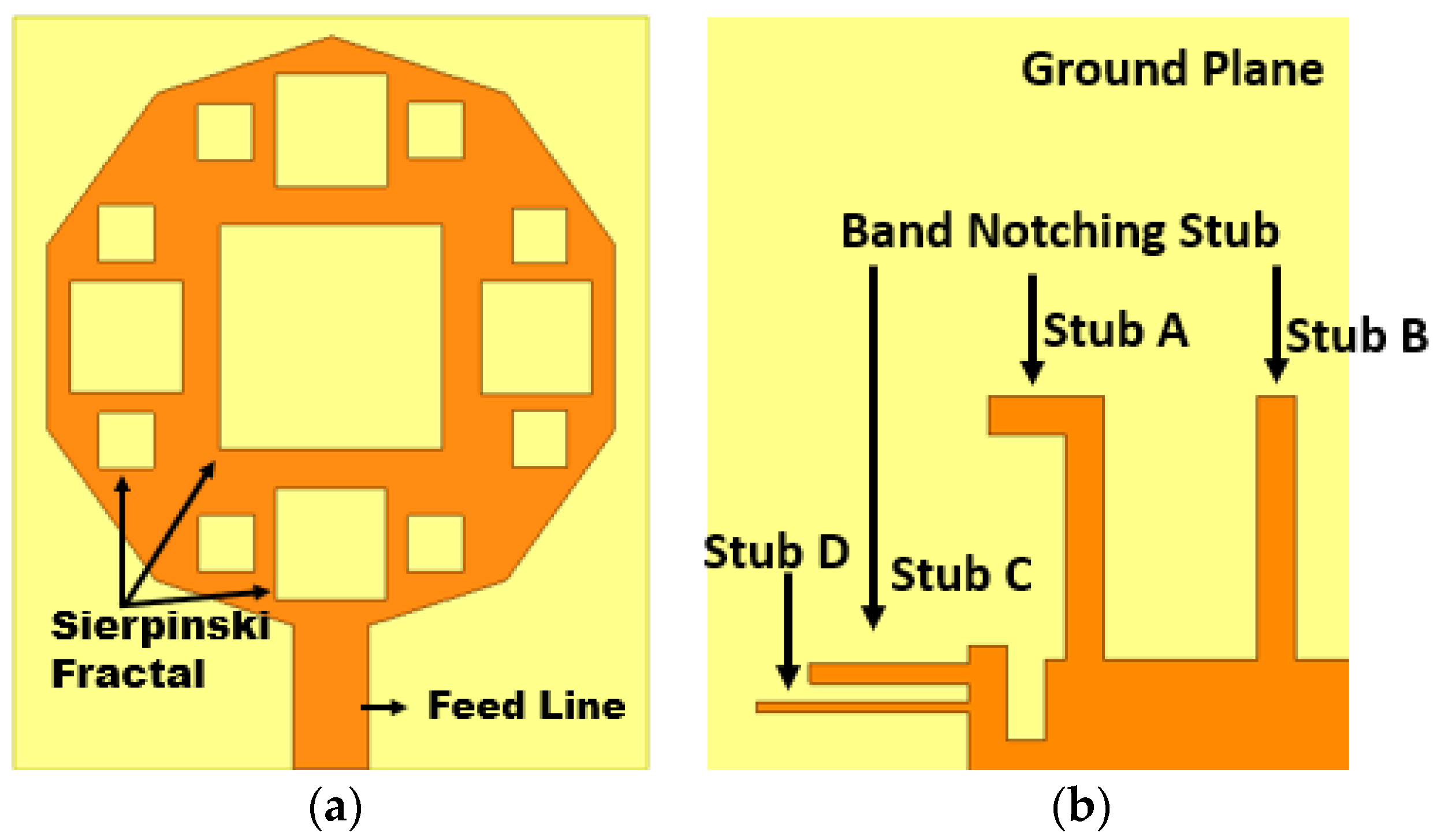



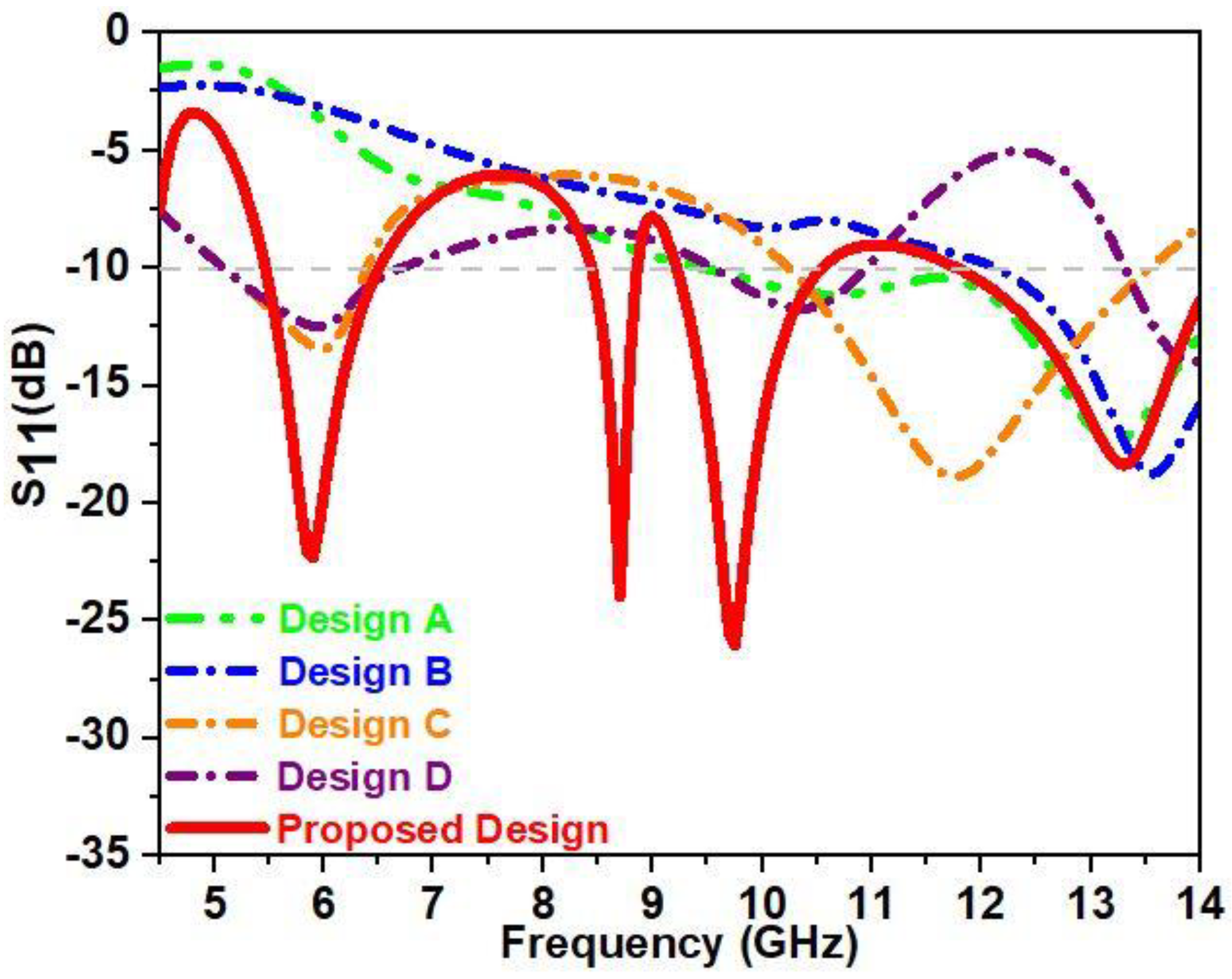
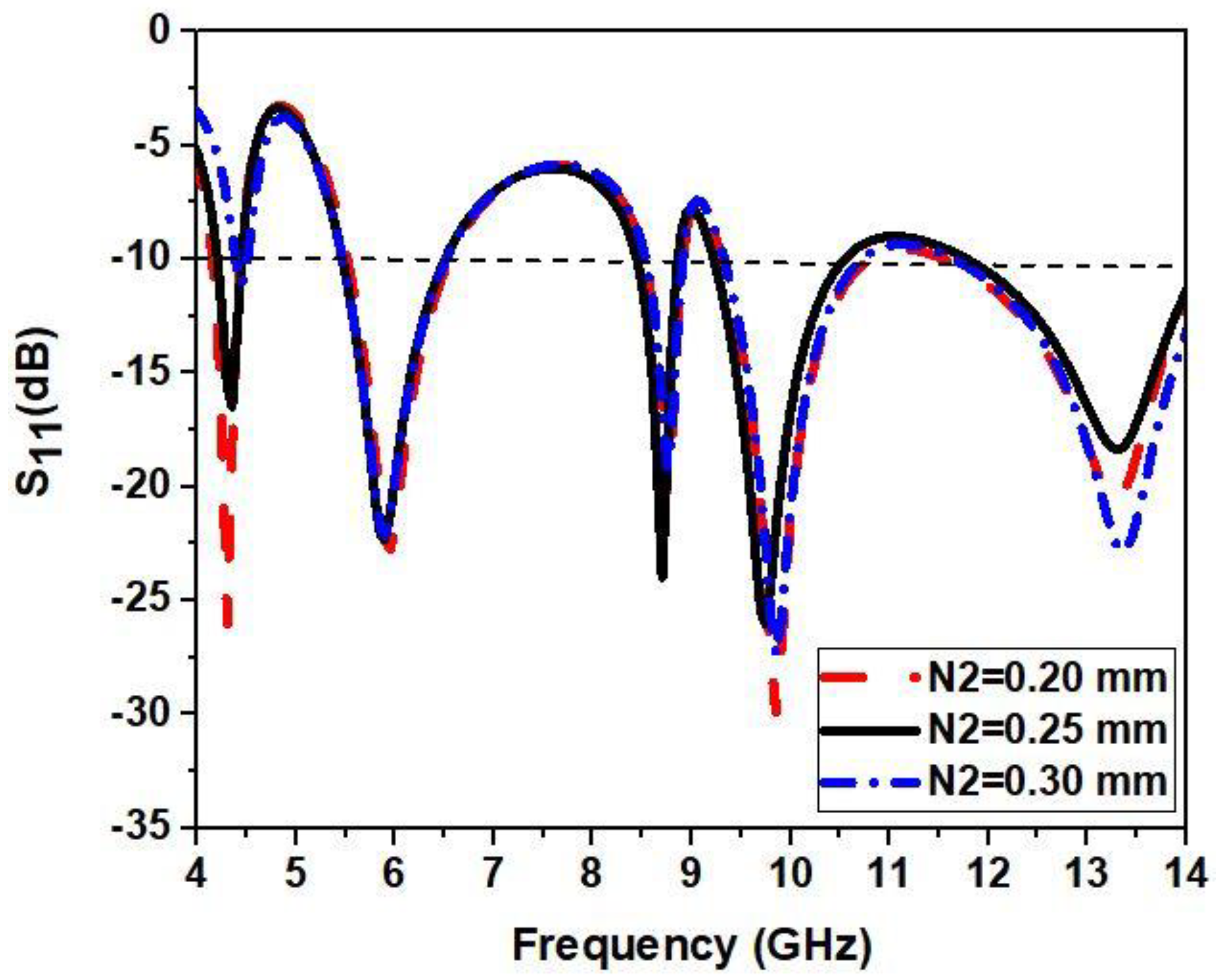
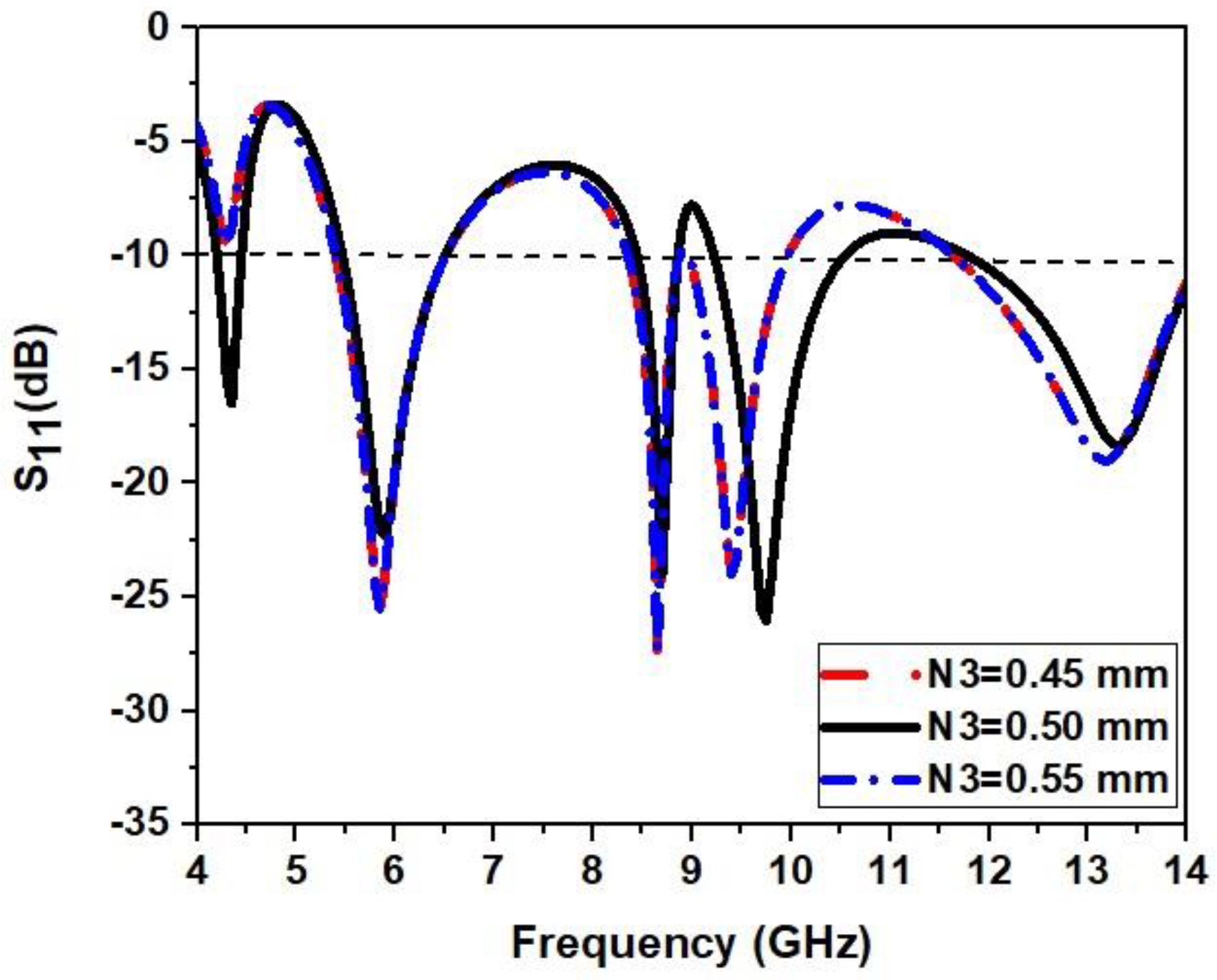

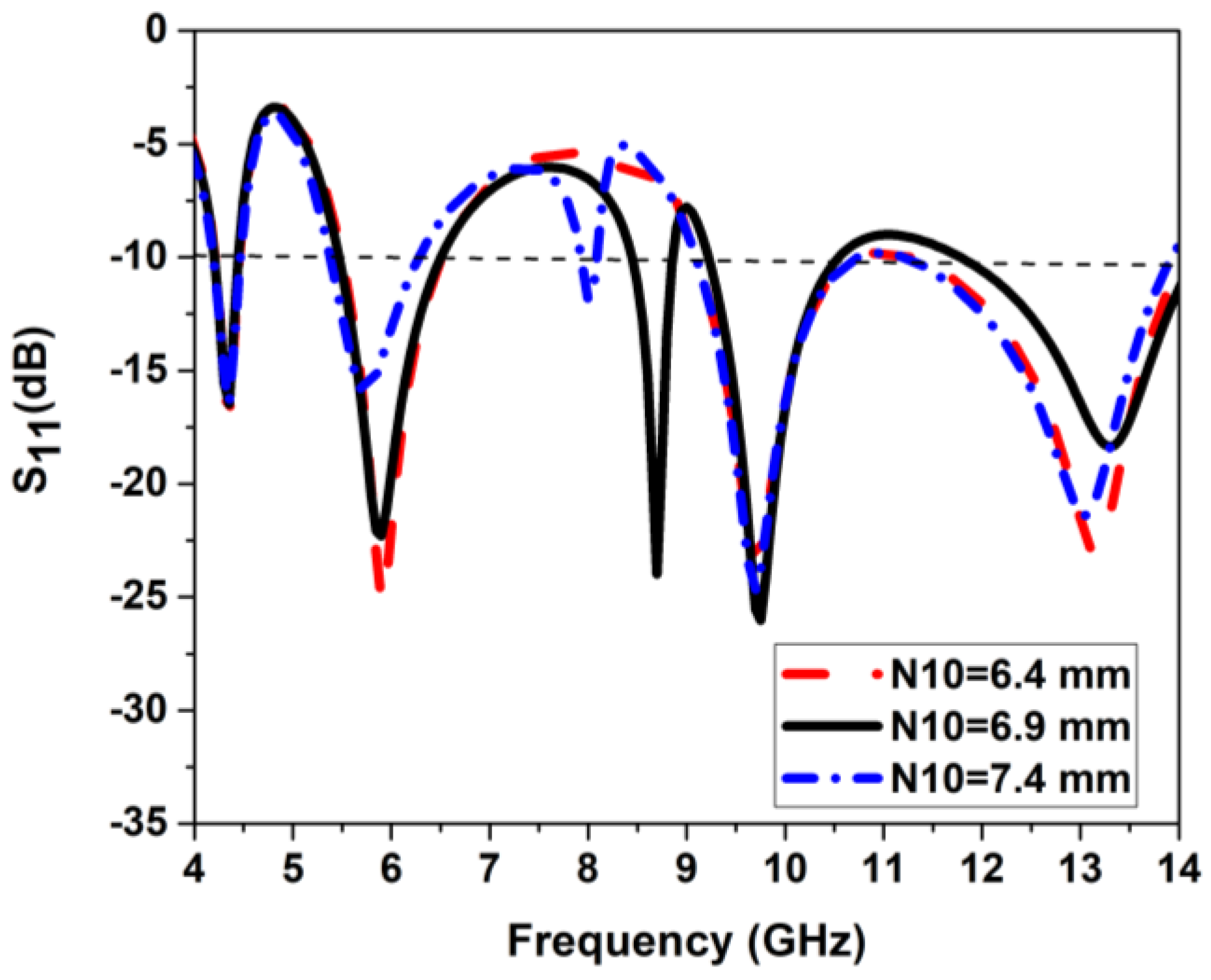

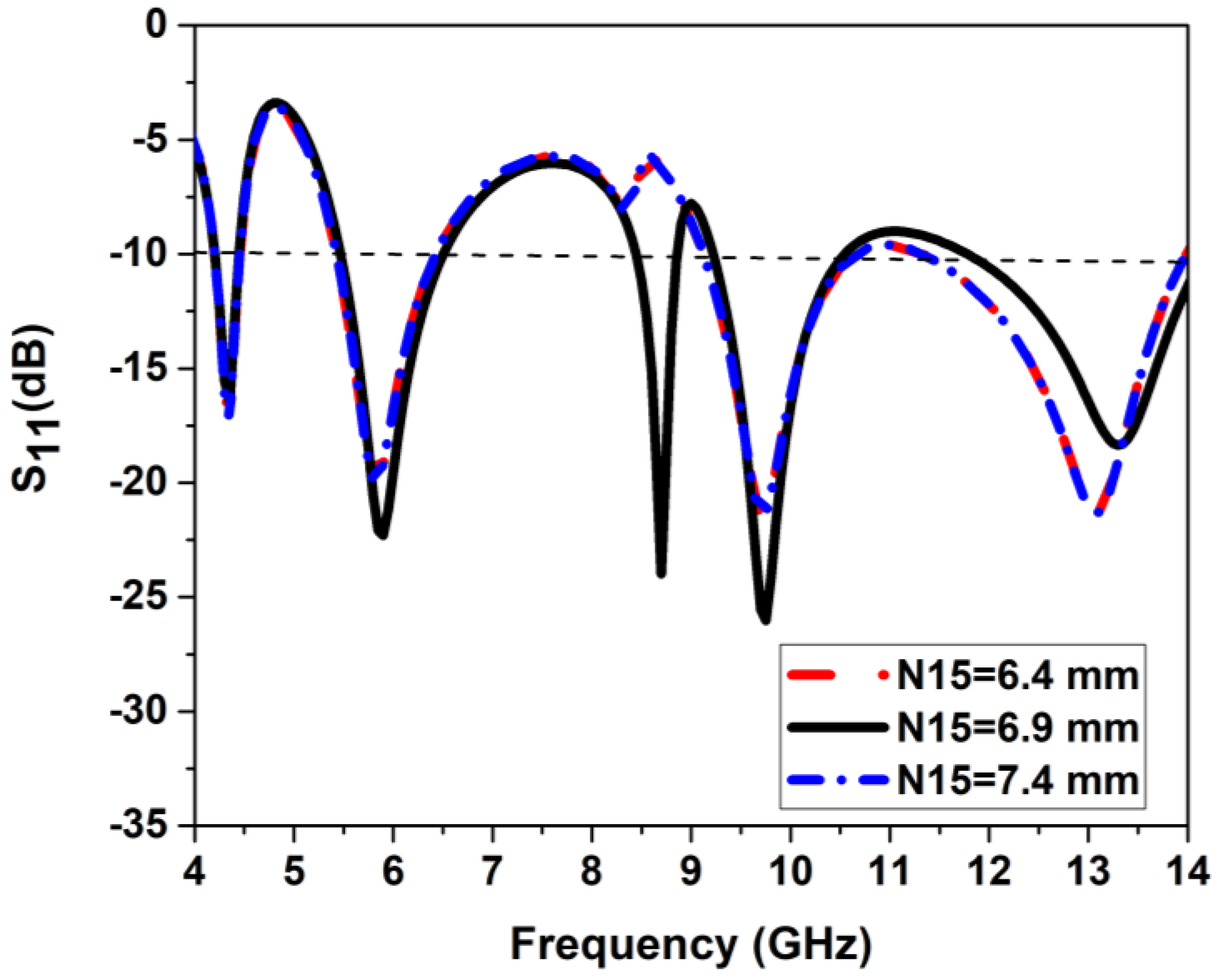

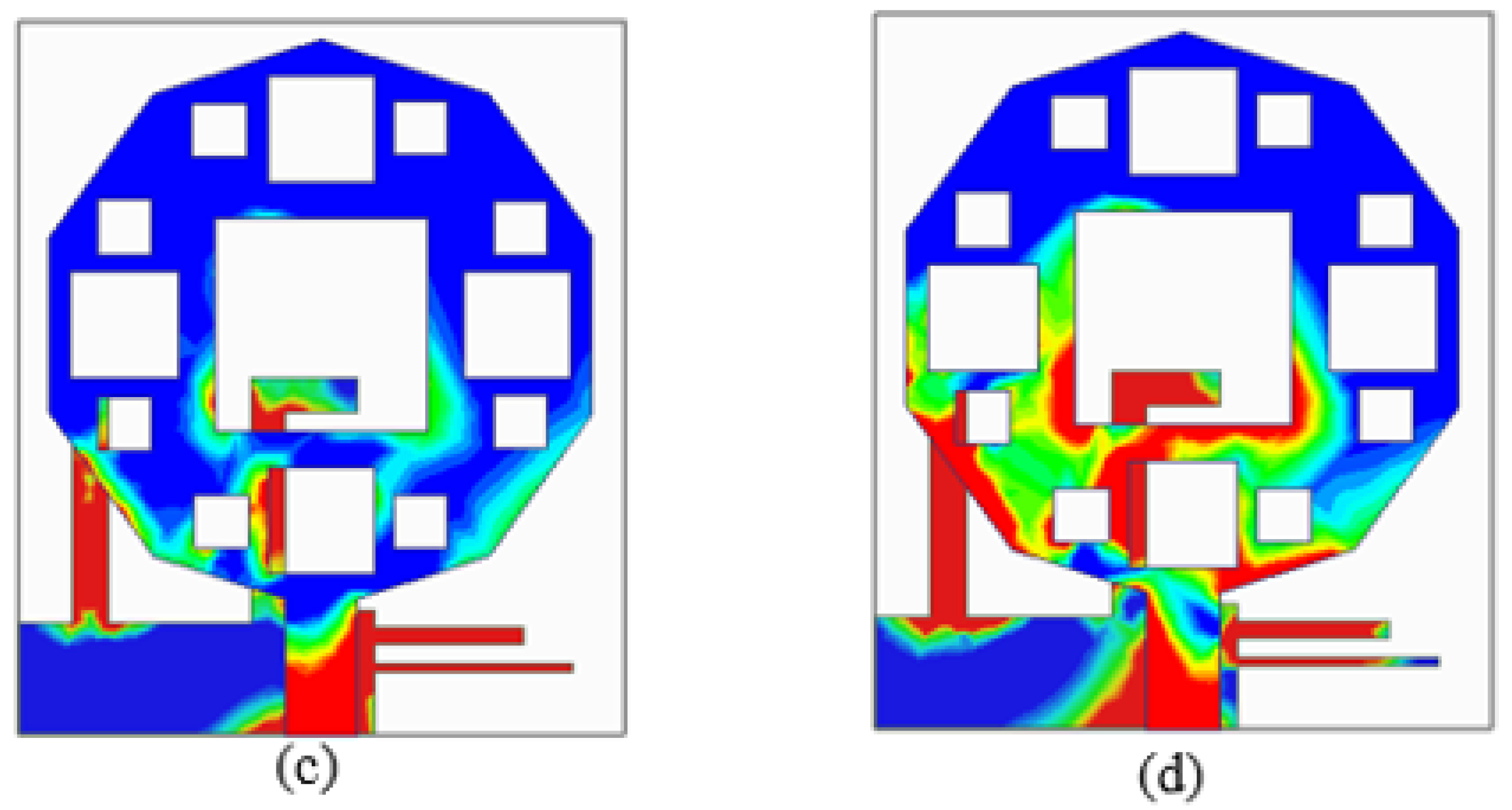


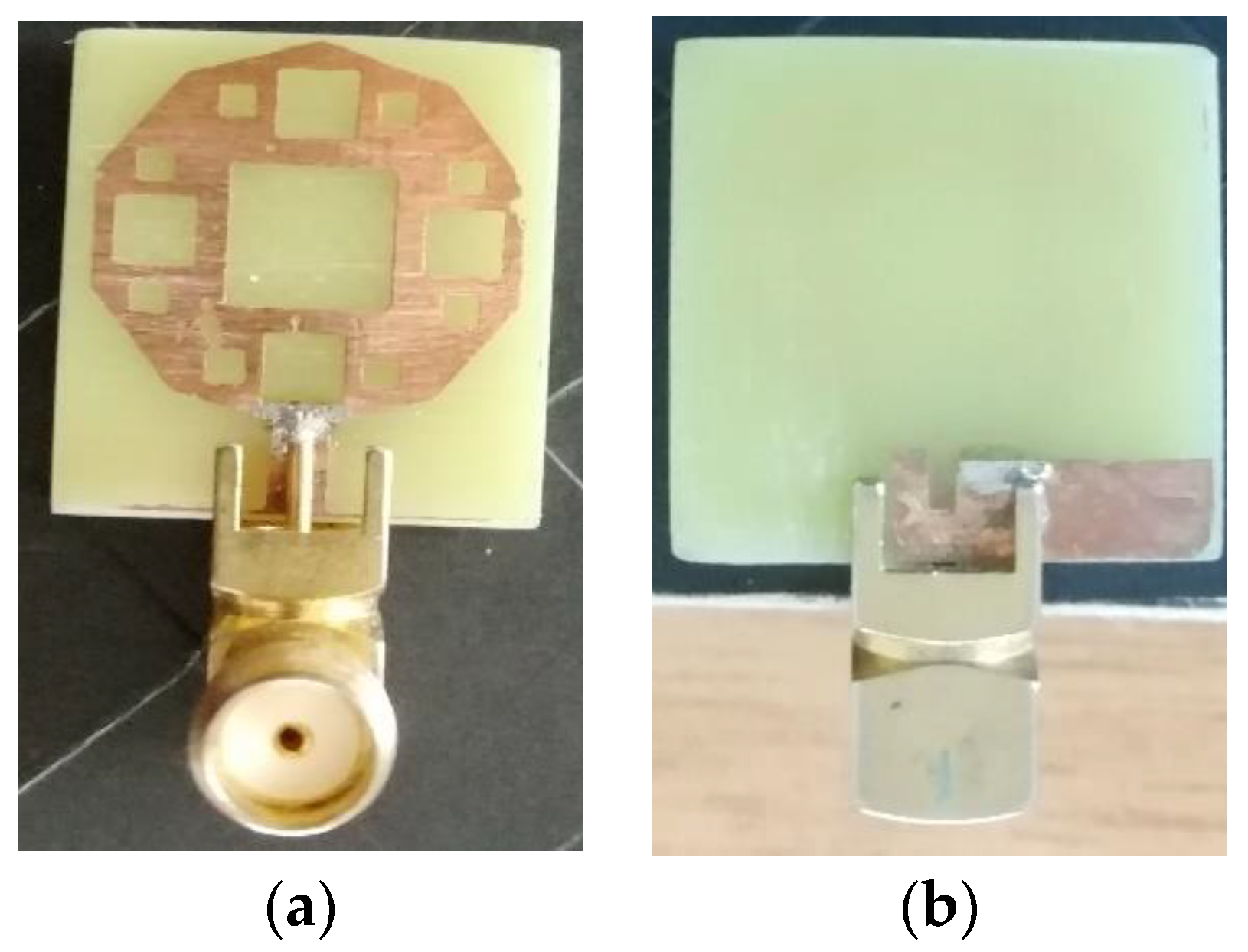


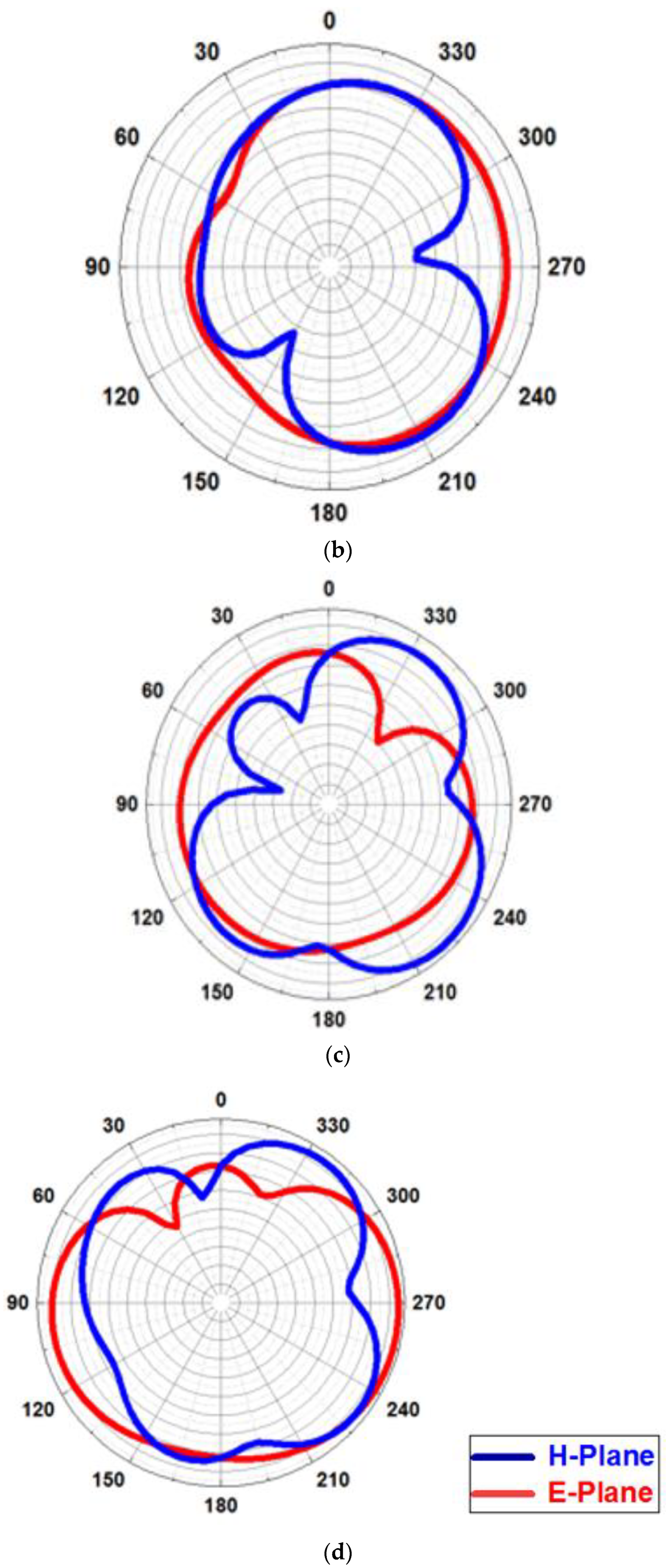
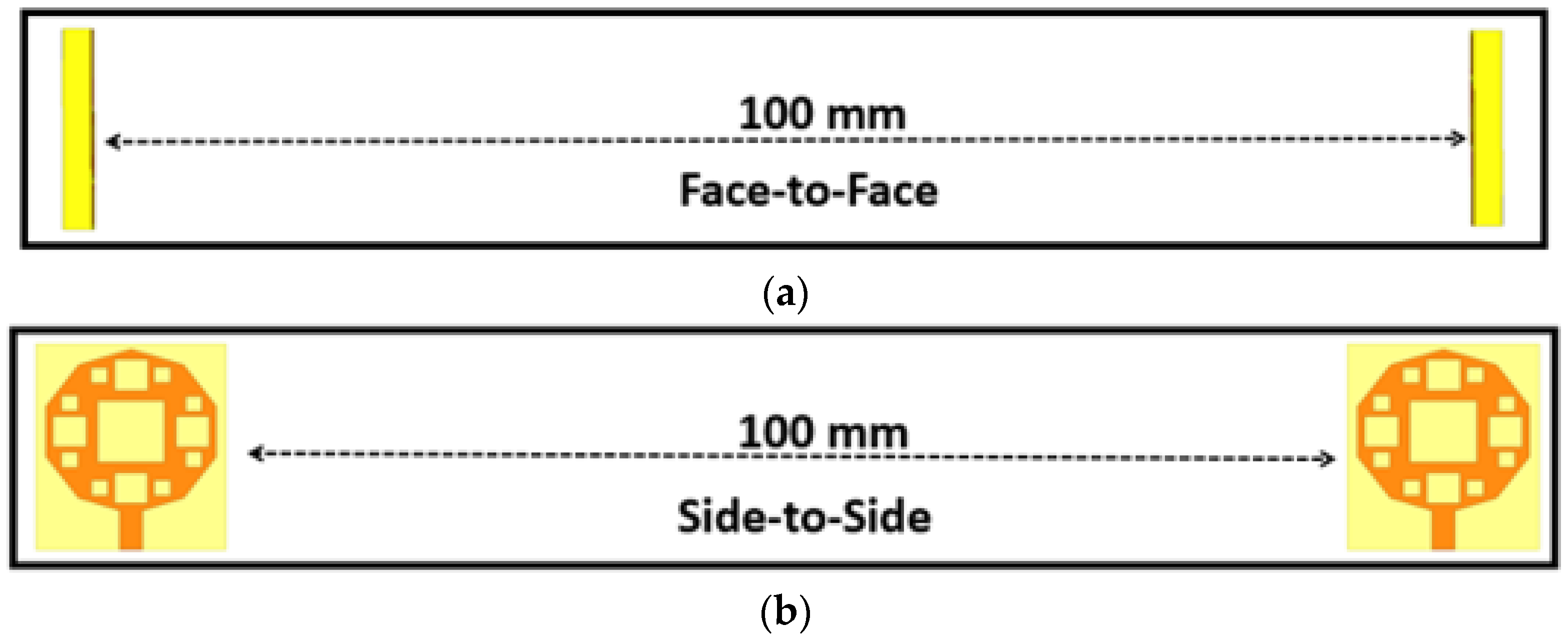
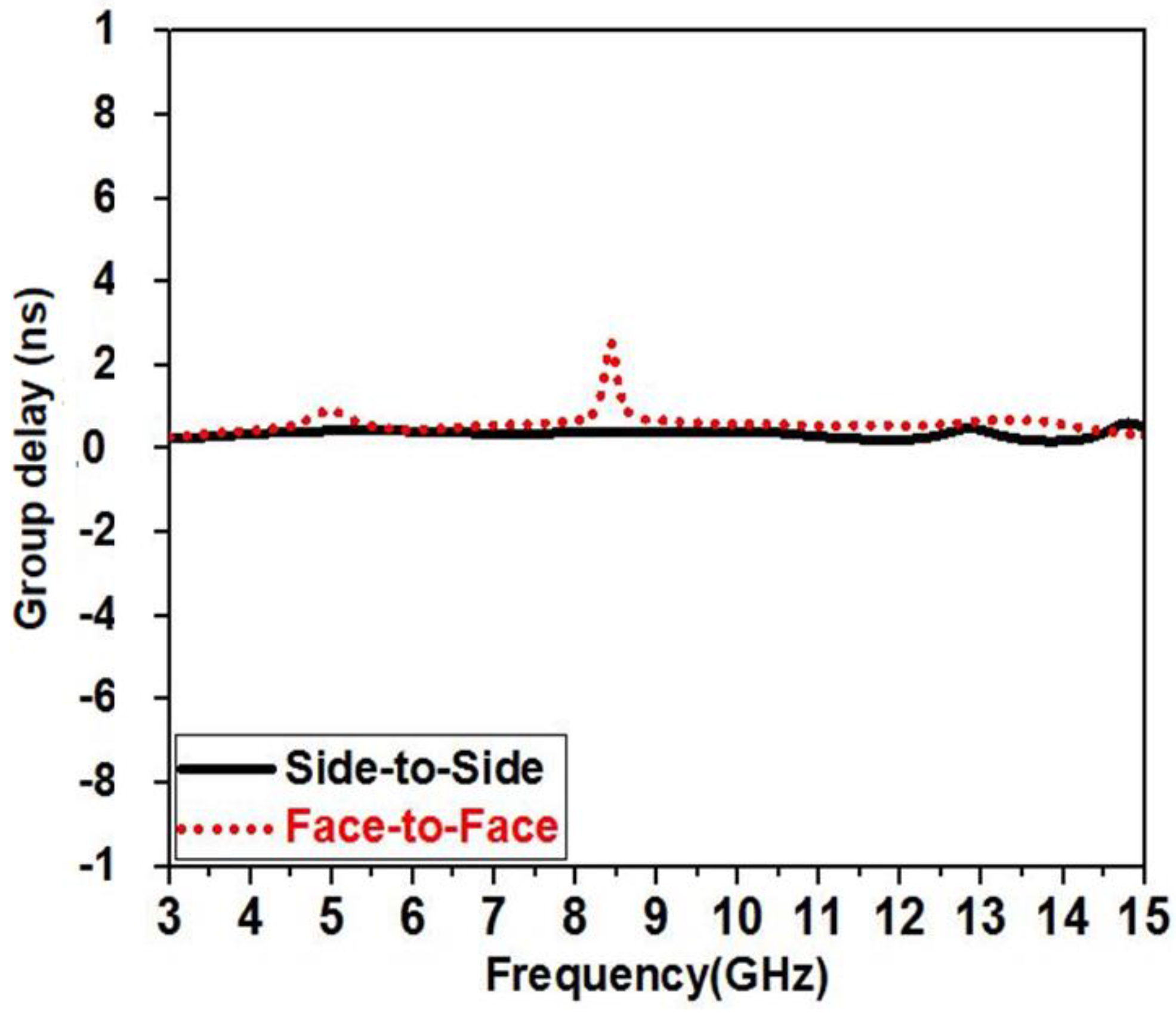
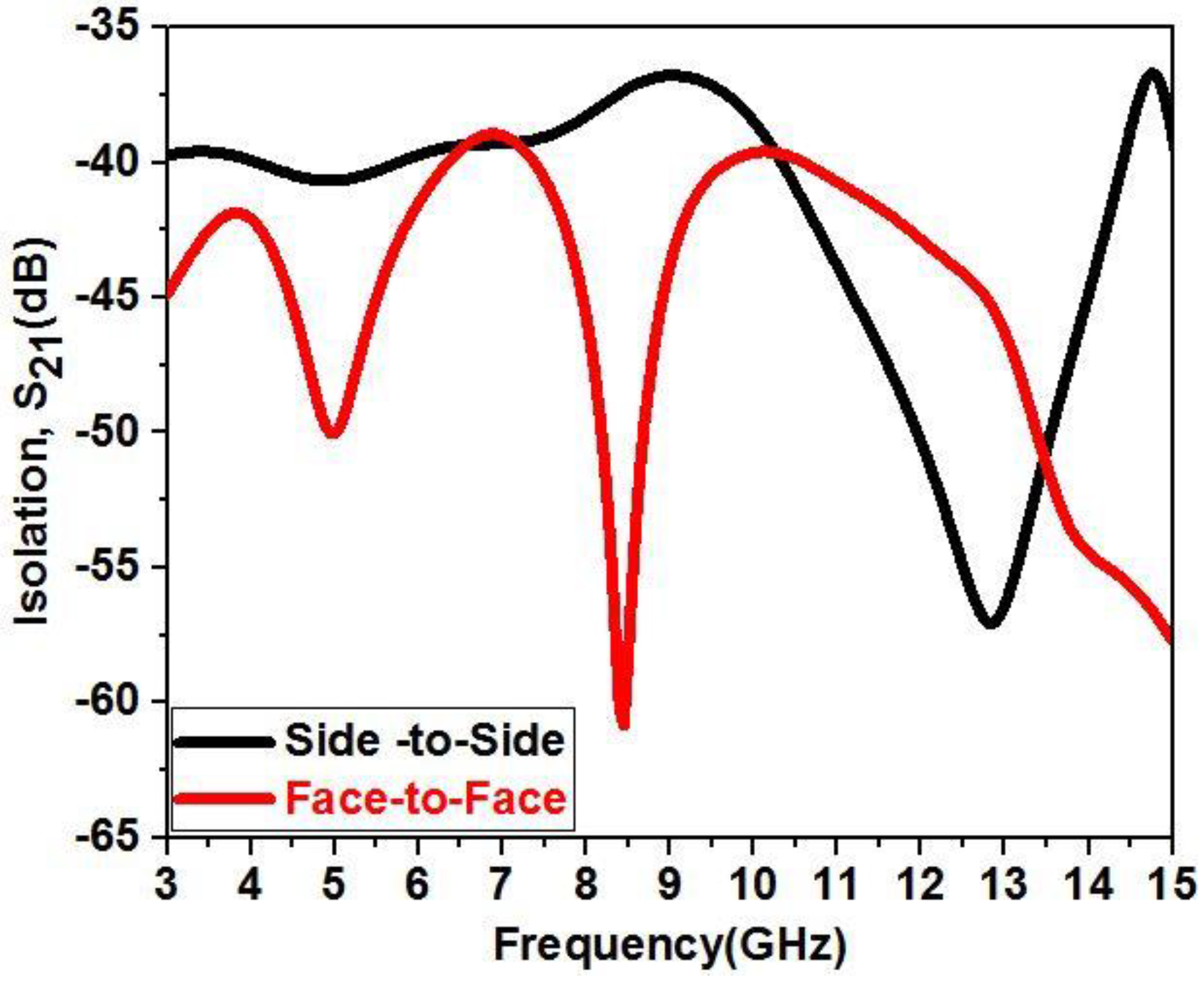
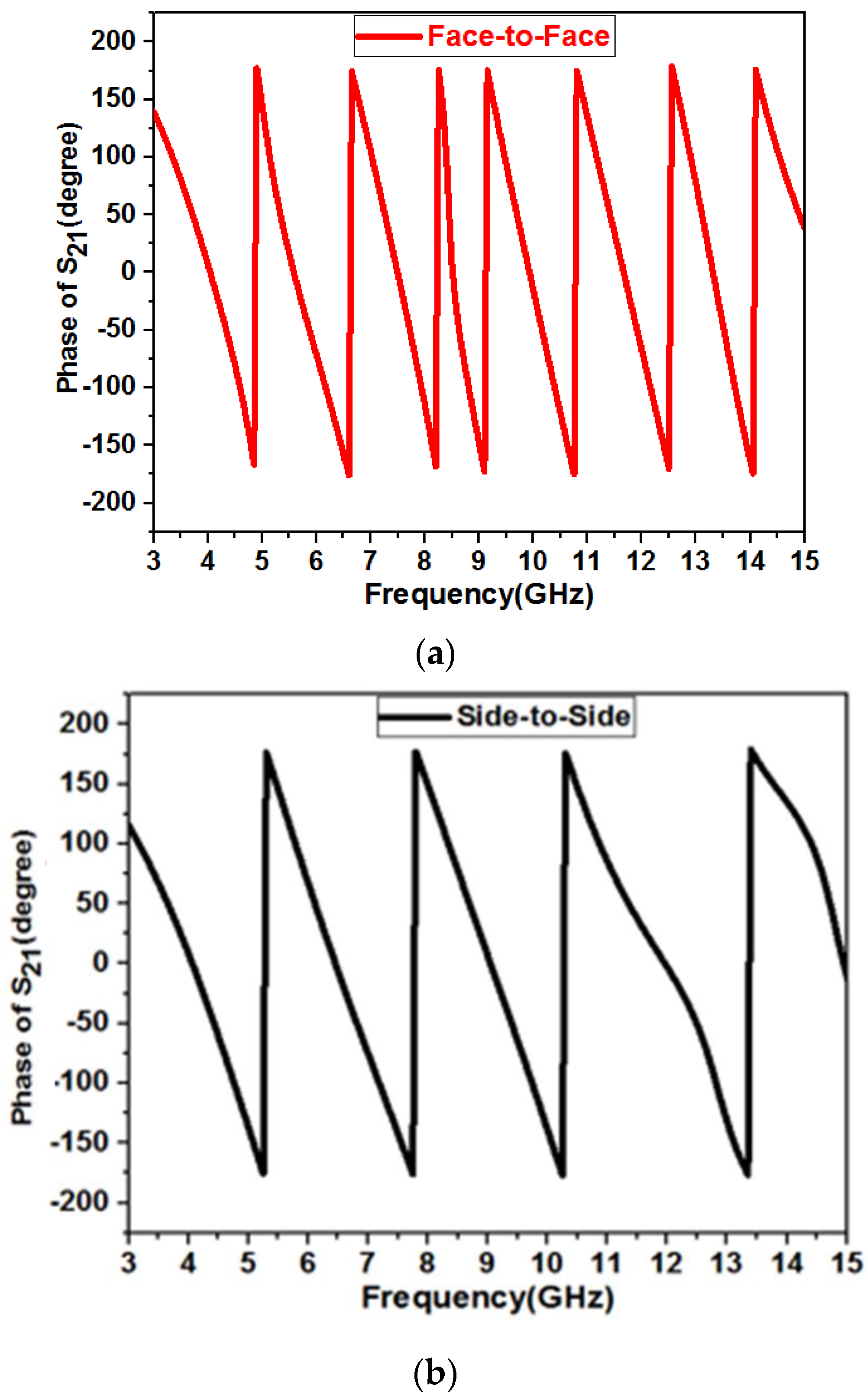


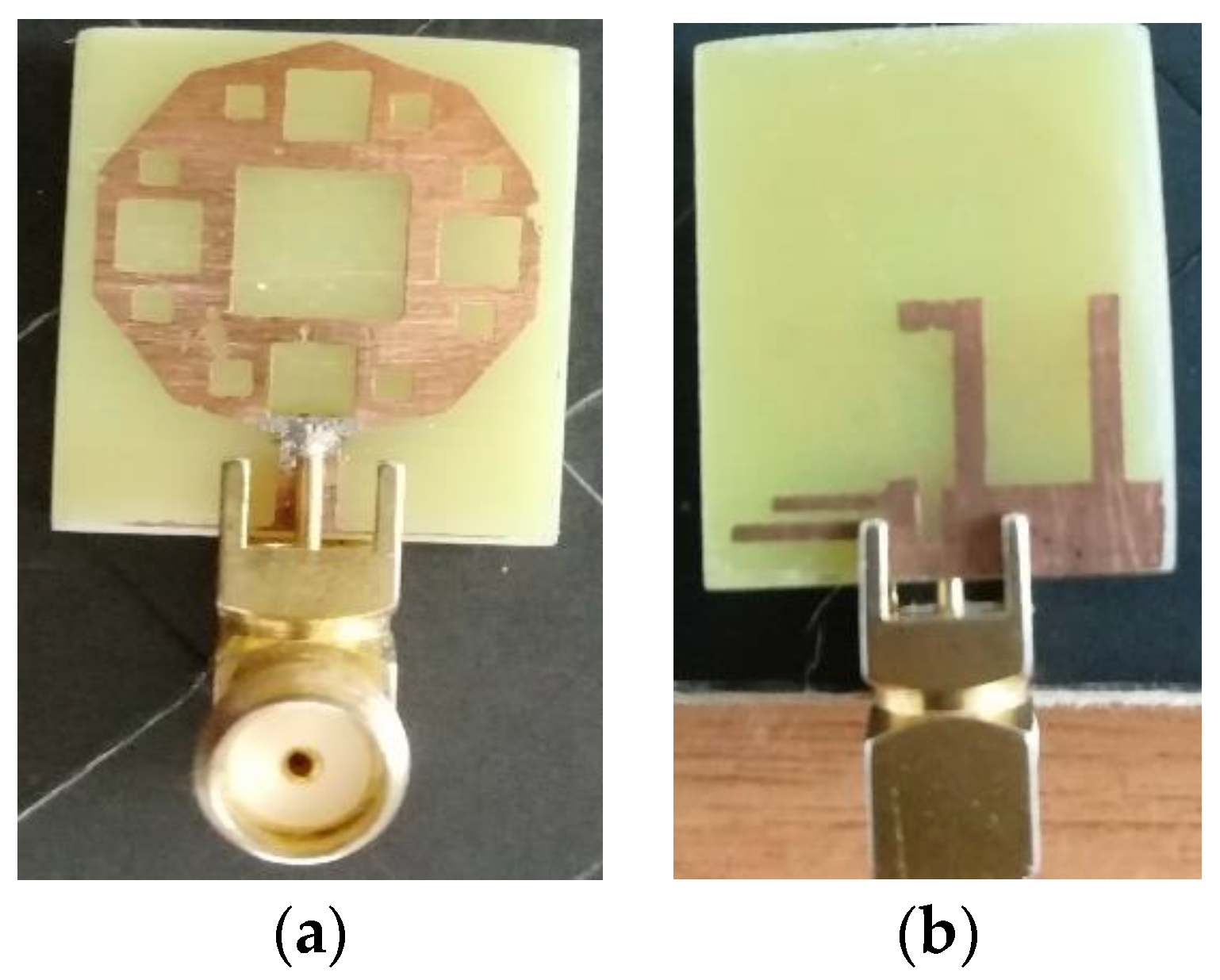

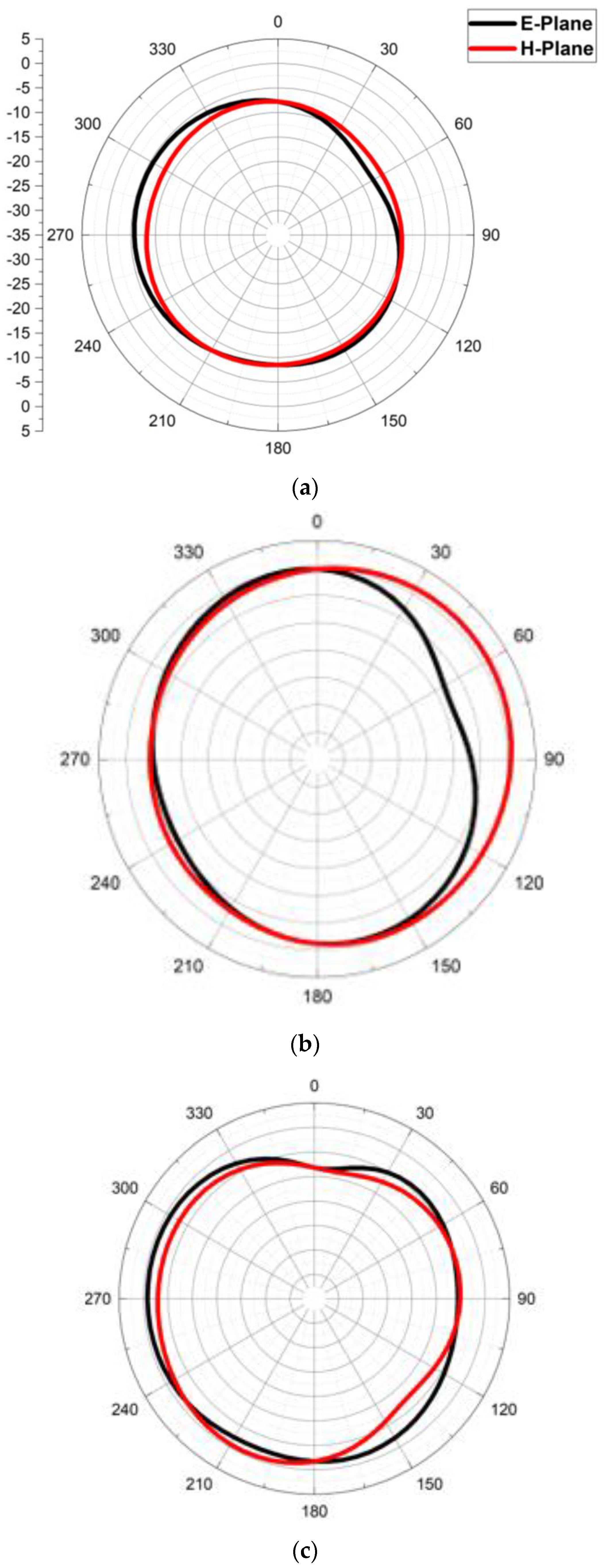



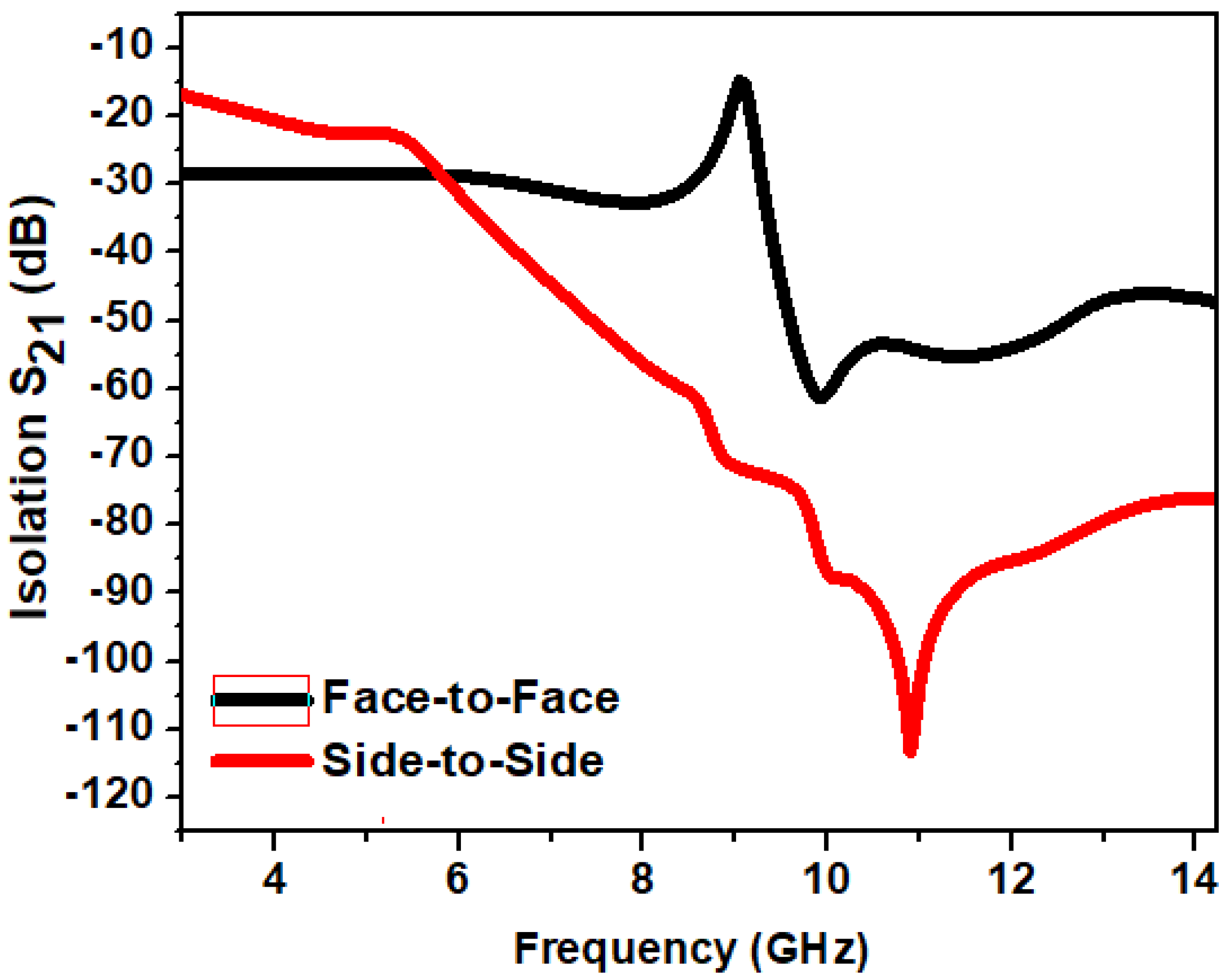


| Parameter | Dimension (mm) | Parameter | Dimension (mm) |
|---|---|---|---|
| W | 17 | S1 | 10 |
| L | 20 | S2 | 3.5 |
| F | 6 | S3 | 1 |
| F1 | 3 | T | 2.5 |
| F2 | 1.5 | T1 | 3.1 |
| LF | 3.82 | A | 15.2 |
| WF | 2 | B | 8.48 |
| S | 1 |
| Parameter | Dimension (mm) | Parameter | Dimension (mm) |
|---|---|---|---|
| W | 17 | N7 | 1 |
| L | 20 | N8 | 4.1 |
| F | 6 | N9 | 3.8 |
| F1 | 3 | N10 | 7 |
| F2 | 1.5 | N11 | 8 |
| N1 | 1.75 | N12 | 1 |
| N2 | 0.25 | N13 | 3 |
| N3 | 0.5 | N14 | 1.5 |
| N4 | 5.5 | N15 | 6.9 |
| N5 | 2.1 | N16 | 1 |
| N6 | 5.5 | N17 | 2 |
| Wf | 2 | Lf | 3.82 |
| Ref. No. | Size (mm2) | Notch Technique | Range (GHz) | No. of Notch Frequencies | Notch Frequency (GHz) | Phase Response | Group Delay | Transfer Function | Radiation Pattern | Design Complexity | |
|---|---|---|---|---|---|---|---|---|---|---|---|
| E-Plane | H-Plane | ||||||||||
| [24] | 32 × 30 | CSRR and circular stubs | 2.76–11 | 2 | 4.1/6 | linear | linear | <−25 dB | Bidirectional | Omnidirectional | No |
| [25] | 34 × 34 | slot in the feed line | 3.1–10.6 | 1 | 5.5 | linear | linear | NA | Omnidirectional | Omnidirectional | Yes |
| [26] | 18.5 × 39 | Quadratic fractal slot | 3.2–12 | 1 | 5.5 | linear | linear | NA | Bidirectional | Omnidirectional | Yes |
| [27] | 50 × 50 | Slot at the fractal structure | 2.1–11 | 2 | 2.5/5.5 | NA | NA | NA | Bidirectional | Bidirectional | Yes |
| [28] | 42 × 32 | SRR slot | 2.7–14.9 | 2 | 4.9/8.2 | NA | NA | NA | Bidirectional | Omnidirectional | No |
| [29] | 30 × 40 | Shorted stubs in parallel | 2–10.6 | 2 | 3.5/5.2 | NA | NA | NA | Bidirectional | Omnidirectional | Yes |
| [30] | 30 × 30 | Combination of stubs and steeped slots | 2.39–11.4 | 2 | 5.3/5.8 | linear | linear | <−20 dB | Bidirectional | Omnidirectional | Yes |
| [31] | 30 × 40 | Rectangular split ring resonator | 2.4–13.8 | 1 | 5.4 | linear | linear | NA | Bidirectional | Omnidirectional | Yes |
| [32] | 50 × 50 | Fractal Kotch and T-shape slot | 1.7–11 | 3 | 2/3.5/5.8 | NA | NA | NA | Omnidirectional | Bidirectional | No |
| [33] | 24.6 × 38.1 | T-shape slot and Rectangular CSRR | 3–11 | 2 | 3.5/5.5 | linear | linear | NA | Bidirectional | Omnidirectional | No |
| [34] | 30 × 36 | Circular SRR | 2.9–12 | 1 | 3.5 | NA | NA | NA | Omnidirectional | Omnidirectional | No |
| Proposed work | 20 × 17 | Sierpinski square fractal slots | 4.21–13.9 | 4 | 5.05/7.8/9.03/10.86 | linear | linear | <−37 dB | Omnidirectional | Omnidirectional | No |
Disclaimer/Publisher’s Note: The statements, opinions and data contained in all publications are solely those of the individual author(s) and contributor(s) and not of MDPI and/or the editor(s). MDPI and/or the editor(s) disclaim responsibility for any injury to people or property resulting from any ideas, methods, instructions or products referred to in the content. |
© 2023 by the authors. Licensee MDPI, Basel, Switzerland. This article is an open access article distributed under the terms and conditions of the Creative Commons Attribution (CC BY) license (https://creativecommons.org/licenses/by/4.0/).
Share and Cite
Kumar, O.P.; Kumar, P.; Ali, T.; Kumar, P.; K, S.B. A Quadruple Notch UWB Antenna with Decagonal Radiator and Sierpinski Square Fractal Slots. J. Sens. Actuator Netw. 2023, 12, 24. https://doi.org/10.3390/jsan12020024
Kumar OP, Kumar P, Ali T, Kumar P, K SB. A Quadruple Notch UWB Antenna with Decagonal Radiator and Sierpinski Square Fractal Slots. Journal of Sensor and Actuator Networks. 2023; 12(2):24. https://doi.org/10.3390/jsan12020024
Chicago/Turabian StyleKumar, Om Prakash, Pramod Kumar, Tanweer Ali, Pradeep Kumar, and Subhash B. K. 2023. "A Quadruple Notch UWB Antenna with Decagonal Radiator and Sierpinski Square Fractal Slots" Journal of Sensor and Actuator Networks 12, no. 2: 24. https://doi.org/10.3390/jsan12020024









